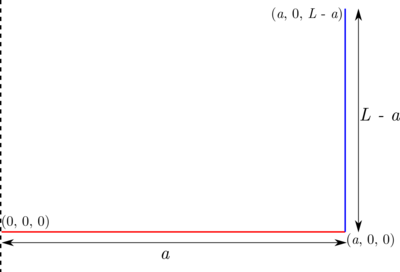Bent Rod Moment
There is a thin uniform rod of mass in the -plane which is initially aligned with the -axis. The body of the rod begins at the origin and ends at .
Suppose that the portion of the rod up to , where remains aligned with the -axis, and the portion from to is bent upwards at a right angle so as to be perpendicular to the -plane.
The bent rod's moment of inertia with respect to the -axis can be expressed as If and are coprime positive integers, determine .
The answer is 5.
This section requires Javascript.
You are seeing this because something didn't load right. We suggest you, (a) try
refreshing the page, (b) enabling javascript if it is disabled on your browser and,
finally, (c)
loading the
non-javascript version of this page
. We're sorry about the hassle.
Let us draw the diagram to make it clear what the shape of the rod is. The rod is drawn in red and blue. The dashed line is the axis about which we are finding the moment of inertia of the rod. kg
It will be simpler to find the moment of inertia of both parts of the rod separately:
Red:
Its mass is L a M . The moment of inertia passing through the rod's endpoints and parallel to the z axis is I r e d = ( L a M ) 3 a 2 .
Blue:
Its mass is L L − a M .The moment of inertia of the blue part passing through its center and parallel to the z axis is 0. Using the parallel axis theorem , its moment of inertia about the given axis is I b l u e = L L − a M a 2 .
The total moment of inertia of the rod is
I = I r e d + I b l u e = 3 L M a 3 + M a 2 − L M a 3 = M a 2 − 3 2 L M a 3
By comparing it to the expression in the problem, we get α = 2 , β = 3 . Therefore α + β = 5 .